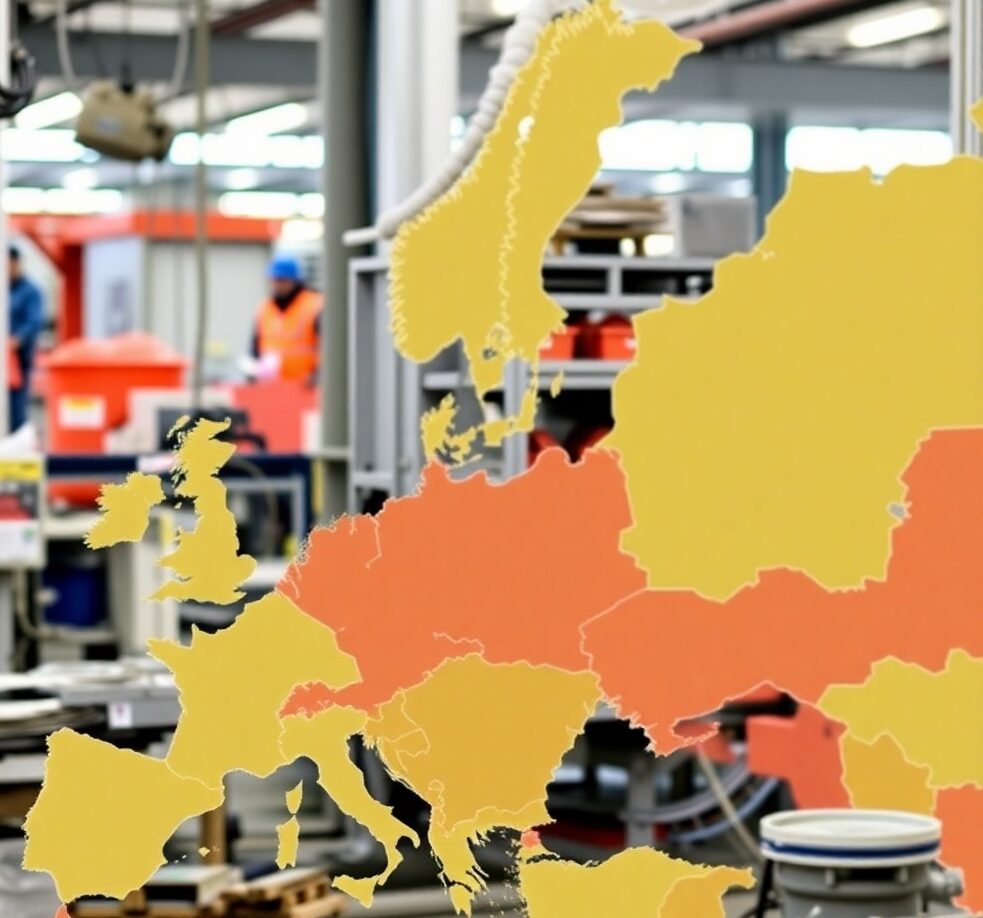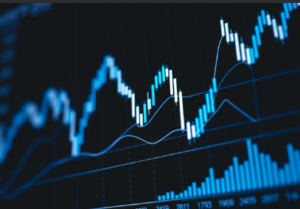
As 2024 draws to a close, the Eurozone’s manufacturing sector finds itself in a state of contraction. Despite expectations of recovery, the latest data reveals that the region’s industrial activity has continued to decline. The Purchasing Managers’ Index (PMI), a key indicator of manufacturing health, stands at 45.1 as of December 2024, signaling a deepening contraction across the continent. This marks yet another disappointing result for an economic bloc already grappling with multiple challenges.
The Eurozone’s manufacturing sector is crucial to its economic performance, as it drives a significant portion of both domestic and international trade. The contraction signals more than just a slowdown in factory output; it reflects broader issues facing the region, including rising energy prices, geopolitical instability, and slow recovery from the economic effects of the COVID-19 pandemic. In this article, we will explore the factors contributing to this contraction, provide a detailed analysis of key European economies, and discuss the implications for 2025.
Understanding the Manufacturing PMI: A Vital Economic Indicator
The PMI is a monthly survey that tracks business conditions in the manufacturing sector. A PMI score below 50 indicates contraction, while scores above 50 point to expansion. As of December 2024, the Eurozone’s PMI has remained below the 50-point mark for over two years, reflecting the ongoing challenges faced by manufacturers.
In December 2024, the PMI for the Eurozone stood at 45.1, a slight improvement over previous months but still deeply in negative territory. This figure represents the weakest annual performance for the sector since 2020, with little indication that the situation will significantly improve in the coming year.
A decline in PMI typically indicates weaker demand for goods, slower production rates, and reduced business confidence. For the Eurozone, this translates into fewer investments, slower GDP growth, and a more fragile economic outlook for 2025. This section will look at the broader economic forces shaping the manufacturing sector’s downturn, including the impact of supply chain disruptions, labor shortages, and rising input costs.
Germany: The Struggles of Europe’s Manufacturing Giant
Germany is often considered the economic engine of the Eurozone, and its manufacturing sector has long been a critical pillar of its economy. However, as of December 2024, the German manufacturing sector is in trouble, with the HCOB Manufacturing PMI plummeting to 42.5. This marks a continued decline, with the country’s industrial output remaining subdued amid weaker domestic and international demand.
The automotive industry, Germany’s cornerstone sector, has faced a dramatic slowdown. The demand for both traditional combustion engine vehicles and electric vehicles has not rebounded as expected, and the sector’s export growth has stagnated. Meanwhile, the high costs of energy and raw materials have added pressure to manufacturers already operating with slim margins.
Germany’s once-strong manufacturing export market has also been affected by geopolitical tensions, particularly with China, one of the country’s largest trade partners. These tensions, compounded by rising protectionist policies worldwide, have led to a decline in German exports, further exacerbating the manufacturing slowdown.
Another contributing factor to Germany’s downturn is the labor market. While job losses in manufacturing have slowed, the country is still facing a tightening labor market, making it difficult for industries to find skilled workers. Although the job losses in Germany’s manufacturing sector have been less severe compared to earlier in the year, the rate of job cuts continues to affect the economy’s overall outlook.
Germany’s government has introduced several stimulus measures to combat the downturn, but recovery remains elusive. This section will explore the specific industries hit hardest by the decline and consider whether Germany’s manufacturing sector can recover in 2025 or if further structural adjustments are needed.
France: Economic Stagnation and Manufacturing Decline
Similar to Germany, France’s manufacturing sector also ended 2024 in contraction. The French PMI fell to 41.9 in December, marking the fastest pace of contraction since mid-2020. France’s industrial base has struggled with several key issues, from high operational costs to political instability, all of which have contributed to weaker-than-expected growth in the manufacturing sector.
In particular, the country’s industrial output has been hampered by the rising costs of energy and raw materials. Manufacturing companies have found it increasingly difficult to maintain profitability as energy prices remain high, while wages and labor costs continue to rise. This has particularly affected the chemical and machinery industries, two of the largest sectors in France’s manufacturing base.
Additionally, France has been dealing with political unrest, which has further strained its industrial capacity. Protests and strikes throughout the year have disrupted production lines and caused delays in critical shipments, adding to the overall economic uncertainty. This political instability, combined with the economic challenges of the manufacturing sector, has left many French companies uncertain about the future.
Despite these issues, some industries in France are showing signs of resilience. The aerospace sector, for example, has continued to perform well, driven by strong international demand. However, these pockets of growth are not enough to offset the broader contraction in the manufacturing industry.
Italy: Stagnation Amid Economic Challenges
Italy, like Germany and France, has faced a prolonged period of stagnation in its manufacturing sector. The country’s PMI remained well below the growth threshold, standing at 46.2 in December. While this represents an improvement from the 12-month low seen in November, it still indicates a contraction in industrial activity.
The Italian manufacturing sector’s struggles are largely tied to weak demand from other Eurozone countries, particularly in the automotive and machinery sectors. Italy’s reliance on exports to other European nations has left it vulnerable to economic slowdowns in these countries, and the current slowdown in Germany and France has had a direct impact on Italy’s industrial performance.
High energy costs have also played a significant role in Italy’s manufacturing challenges. The country’s manufacturing base relies heavily on energy-intensive industries, and as energy prices have risen, production costs have escalated. These increased costs have made it more difficult for Italian manufacturers to remain competitive in global markets, contributing to the overall contraction in the sector.
Despite these difficulties, Italy’s manufacturing sector is showing some resilience in select industries, particularly in food production and fashion. These industries have maintained steady demand, even as other sectors struggle. This section will delve deeper into Italy’s specific manufacturing challenges and explore the potential for recovery in the coming year.
Spain: A Bright Spot in an Otherwise Gloomy Outlook
In contrast to its European counterparts, Spain has seen growth in its manufacturing sector. Spain’s PMI rose to 53.3 in December, marking 11 consecutive months of expansion. This growth places Spain as a standout performer in the Eurozone, as its manufacturing sector continues to outperform expectations.
Several factors contribute to Spain’s success. First, the country has seen strong demand from both domestic and international markets. Exports to neighboring European countries and North Africa have remained robust, particularly in sectors such as automotive, chemicals, and food production. Spain has also benefitted from a relatively lower cost of labor compared to other major Eurozone economies, making its manufacturing sector more competitive.
Additionally, Spain’s diverse industrial base, which spans a variety of sectors, has allowed the country to weather the broader economic downturn better than other nations. The resilience of the Spanish manufacturing sector has raised questions about whether this growth can be sustained in 2025, especially given the broader slowdown in the Eurozone.
The Implications for the Eurozone Economy in 2025
The contraction of the Eurozone’s manufacturing sector has significant implications for the region’s broader economic outlook. Manufacturing is a critical driver of GDP, and a continued slowdown in this sector can translate into slower economic growth, reduced employment, and lower levels of investment.
In the short term, policymakers in the Eurozone will need to find ways to address the challenges facing the manufacturing sector. This may involve further stimulus measures, such as investment in infrastructure, targeted support for struggling industries, and efforts to improve supply chain resilience.
In the long term, the Eurozone may need to make structural adjustments to ensure that its manufacturing sector remains competitive in an increasingly globalized world. This could involve investing in automation, diversifying supply chains, and strengthening trade relationships with key partners.
A Challenging Road Ahead for the Eurozone
As the Eurozone manufacturing sector ends 2024 in contraction, the outlook for 2025 remains uncertain. While some countries, such as Spain, have shown resilience, the region as a whole is facing significant challenges. The decline in manufacturing activity, coupled with rising energy costs and geopolitical tensions, leaves little room for optimism in the near future.
In the coming months, the Eurozone’s manufacturing sector will need to adapt to changing economic conditions. Whether through innovation, improved trade agreements, or political stability, the region’s industrial base must find ways to recover and position itself for success in 2025 and beyond.
The next year will be critical in determining whether the Eurozone can turn the tide and reignite growth in its manufacturing sector. For now, all eyes are on the region’s economic policymakers and industrial leaders as they navigate this challenging period.
Feel free to check out our other website at : https://synergypublish.com


